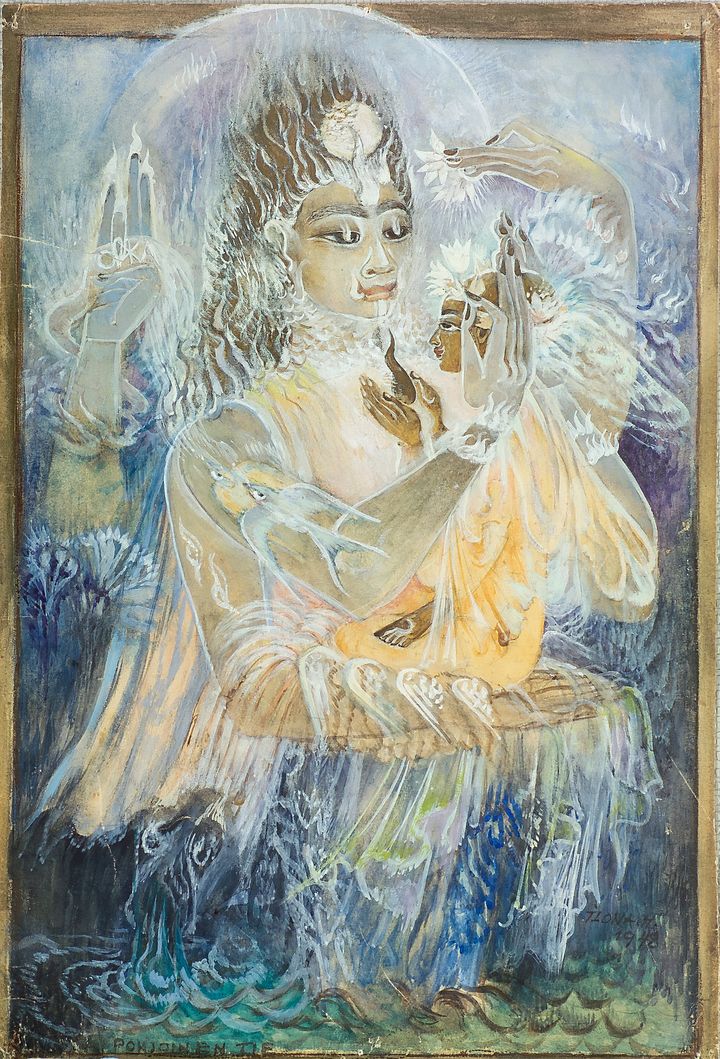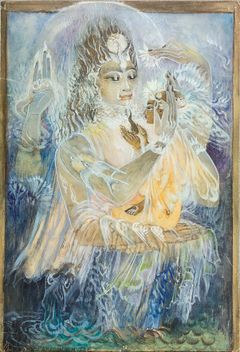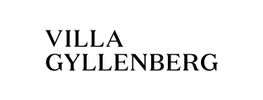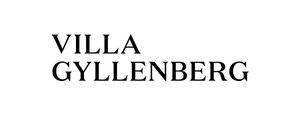REMINDER: Invitation to press conference on 25th April for Eastern Spirituality at Villa Gyllenberg Art Museum

Press release
Eastern Spirituality at Villa Gyllenberg 26.4–13.8.2023
Imaginings of Buddhism, the ancient cultures of India and the sages of the East have inspired many artists. This history is intertwined with problematic confrontations and power relations, but also with a genuine desire to understand and learn from other cultures. The new exhibition presents art from the 19th century to the present by more than twenty artists, including Akseli Gallen-Kallela, Ilona Harima, Anitra Lucander and J.O. Mallander. The exhibition offers new perspectives on the history of Finnish art and is based on the pioneering research of Nina Kokkinen, Ph.D., who has previously studied esoteric spirituality.
Finding answers in Eastern spirituality
Answers to the challenges of today's hectic lives are often sought in yoga, meditation, trips to Asia and homes decorated with images of Buddha. Eastern religions have long inspired artists to collect artefacts, travel, contemplate and seek new ways of approaching both artmaking and their own spirituality. A deeper, more authentic spirituality was sought from the East and its religions.
“My dissertation dealt with esotericism in the art of Akseli Gallen-Kallela, Pekka Halonen and Hugo Simberg. During my research, it became clear that the ideas about Eastern spirituality are closely intertwined with esotericism, and these topics were also of great interest to artists who worked later in the 20th century. For some, like Ilona Harima and Anitra Lucander, Eastern spirituality became an important part of their lives. This exhibition highlights the influence of Eastern spirituality on art and culture as a broader phenomenon and examines its development over a period of more than a hundred years,” says Nina Kokkinen, curator of the exhibition.
Fascinating life stories and art
The exhibition highlights interesting works, fascinating life stories and artefacts in which notions of Eastern spirituality have lived on in Finnish art and culture. Over a period of a hundred years, Eastern spirituality gained different expressions and was used to describe bohemian life, the pursuit of spiritual development, and conceptual avant-garde. In addition to visual art, the exhibition includes historical photographic material and religious artefacts collected by e.g. Gustaf Mannerheim and Akseli Gallen-Kallela.
“Ane Gyllenberg had a profound interest in spirituality and collected not only works related to Christianity but also Buddhist artefacts. He also acquired two works by Ilona Harima that have rarely been exhibited in the museum. Harima was rumoured to create art in a kind of trance state, and she depicted her own spirit guides in her works. I invited Nina Kokkinen to curate this exhibition at Villa Gyllenberg to shed light on the importance of the Eastern religious sculptures in Finnish collections and how artists have drawn from Eastern religions in different periods,” says Lotta Nylund, Chief Curator of the Villa Gyllenberg Art Museum.
Art permeated with Eastern Spiritualism
Eastern spirituality has had a wide influence on all fields of art and culture. In addition to fine art and collecting, the exhibition sheds light on the influence of Eastern spirituality on the dance art of the early 20th century. The enthusiasm for oriental dance experienced in Finland also highlighted the religious nature of Asian dance and theatre art. Dancers began to move in a way characteristic of yoga, meditation and the ritual sign language of the East. They were seen to express their connection to cosmic harmony through their body and movement. Artists were inspired to depict dancers as saints, angels and mediums with extrasensory abilities.
The influence of Eastern spirituality in the early 20th century was also visible in literature and illustration art, such as the beloved fairy tale illustrations of Rudolf Koivu. Along with works related to Buddhism, artists also read works such as the Bhagavad Gita, the holy book of Hinduism.
Travel and meditation
Perceptions of Eastern spirituality became increasingly concretised as tourism proliferated after the Second World War. During their travels, artists gained first-hand experiences of Hinduism, Buddhism and Islam, and artists like Per Stenius and Anitra Lucander sought the counsel of spiritual teachers in India.
In the 1970s, numerous communities based on Eastern religions were founded in Finland, and gurus and other spiritual teachers paid visits to Finland. Artists were often involved in organising these visits.
Eastern spirituality became intertwined with avant-garde and artistic experimentation. It also increasingly gained conceptual and philosophical expressions. Art approached meditation. Towards the end of the 20th century, the importance of the artistic process grew and began to acquire ritualistic dimensions. J. O. Mallander’s Wang is named after a Buddhist ritual, and Silja Rantanen’s series of large paintings draws from the tradition of tantric art.
The exhibition is curated by Dr. Nina Kokkinen (The Donner Institute) and is based on her broader research project on ‘Eastern spirituality’ in Finnish art. In 2020, Kokkinen curated the acclaimed exhibition The Path to Hidden Knowledge at Villa Gyllenberg.
The artists featured in the exhibition are: Wäinö Aaltonen, Eva Bremer, Carolus Enckell, Akseli Gallen-Kallela, Meri Genetz, Ilona Harima, Werner von Hausen, Outi Heiskanen, Ester Helenius, Rudolf Koivu, Inari Krohn, J. O. Mallander, Ahti Lavonen, Anitra Lucander, Leena Luostarinen, Silja Rantanen, Venny Soldan-Brofeldt, Per Stenius, Matti Visanti, Hannu Väisänen and Jan Kenneth Weckman.
For media
The press conference will be held Tuesday 25th of April at 11 a.m. at Villa Gyllenberg, Kuusisaarenpolku 11, 00340 Helsinki. Registrations: siiri.oinonen@gyllenbergs.fi
The exhibition’s curator Nina Kokkinen and Lotta Nylund, Chief Curator and project manager for the exhibition, will be available for interviews.
Contacts and interview requests
Lotta Nylund, Chief Curator, Villa Gyllenberg, lotta.nylund@gyllenbergs.fi, +358 40 576 1753
Nina Kokkinen, Exhibition Curator, nina.kokkinen@stiftelsenabo.fi
Opening hours, tickets and group bookings
Opening hours: Wed, Sat, Sun 12–17 and other times for group bookings
Admission: 12/10 € (0 € for under 18s and with Museum Card)
Group bookings: villa@gyllenbergs.fi
Keywords
Contacts
Lotta NylundIntendenttiVilla Gyllenberg
Tel:+358 40 576 1753lotta.nylund@gyllenbergs.fiImages

Links
About Villa Gyllenberg
Villa Gyllenberg on Signe ja Ane Gyllenbergin säätiön ylläpitämä koti- ja taidemuseo Helsingin Kuusisaaressa. Museo on auki ke, la, su klo 12-17 sekä tilauksesta ryhmille.
Subscribe to releases from Villa Gyllenberg
Subscribe to all the latest releases from Villa Gyllenberg by registering your e-mail address below. You can unsubscribe at any time.
Latest releases from Villa Gyllenberg
Ett spanskt konstverk som man antagit vara försvunnet i århundraden finns på Granö i Helsingfors14.10.2025 12:05:00 EEST | Pressmeddelande
Målningen Petrus Martyren (ca 1650–1655) som visas på konstmuseet Villa Gyllenberg har bekräftats vara ett verk av den spanske barockmästaren Antonio del Castillo y Saavedra (1616–1668). Forskning och internationellt samarbete har visat att verket hör till en serie föreställande helgon från klostret San Pablo.
Vuosisatoja kadonneeksi luultu espanjalainen taideteos sijaitsee Helsingin Kuusisaaressa14.10.2025 12:05:00 EEST | Tiedote
Villa Gyllenbergin taidemuseossa esillä oleva maalaus Pietari Marttyyri (n. 1650–1655) on vahvistunut espanjalaisen barokkitaiteen mestari Antonio del Castillo y Saavedran (1616–1668) teokseksi. Tutkimuksen ja kansainvälisen yhteistyön tuloksena on selvinnyt, että teos on osa San Pablon luostariin kuulunutta pyhimyksiä esittävää sarjaa.
Spanish painting thought lost for centuries found in Finland14.10.2025 12:05:00 EEST | Press release
The painting Saint Peter Martyr (c. 1650–1655) on display at Villa Gyllenberg Art Museum has been confirmed to be a work by the Spanish Baroque master Antonio del Castillo y Saavedra (1616–1668). Research and international cooperation have revealed that the work is part of a series of paintings depicting saints that originally belonged to the Dominican monastery of San Pablo in Córdoba, Spain.
Villa Gyllenbergs konstmuseum efterlyser verk av kvinnliga finländska skulptörer3.6.2025 08:55:00 EEST | Pressmeddelande
Konstmuseet Villa Gyllenberg kartlägger skulpturer av kvinnliga finländska skulptörer från 1800-talet och början av 1900-talet som ingår i inhemska offentliga och privata samlingar. Kartläggningen görs inför en utställning Villa Gyllenberg planerar för 2027. Finska kvinnors arbete med skulptur har inte presenterats i denna omfattning tidigare, och den kommande utställningen baseras på ny forskning. Utställningens kurator är FD Liisa Lindgren.
Villa Gyllenbergin taidemuseo etsii suomalaisten kuvanveistäjänaisten teoksia3.6.2025 08:55:00 EEST | Tiedote
Taidemuseo Villa Gyllenberg kartoittaa suomalaisten 1800-luvun ja 1900-luvun alun naiskuvanveistäjien teoksia, jotka kuuluvat kotimaisiin julkisiin ja yksityisiin kokoelmiin. Teoskartoitus liittyy Villa Gyllenbergiin vuodelle 2027 suunnitteilla olevaan näyttelyyn. Kuvanveiston parissa työskennelleiden suomalaisten naisten töitä ei ole aiemmin esitelty tässä laajuudessa, ja tuleva näyttely perustuu uuteen tutkimukseen. Kuraattorina toimii FT Liisa Lindgren.
In our pressroom you can read all our latest releases, find our press contacts, images, documents and other relevant information about us.
Visit our pressroom
